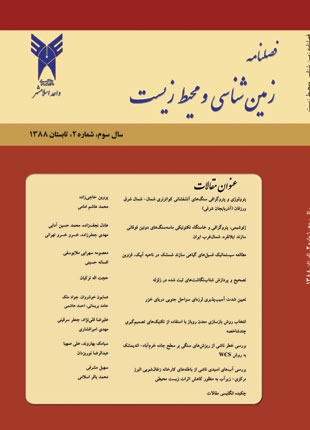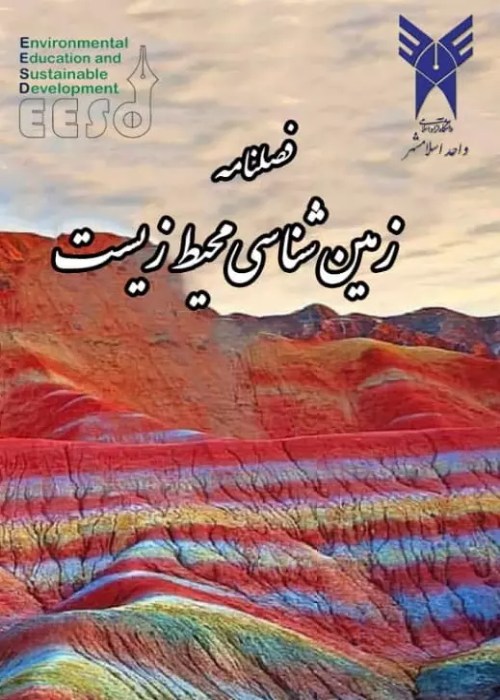فهرست مطالب

نشریه زمین شناسی محیط زیست
پیاپی 7 (تابستان 1388)
- تاریخ انتشار: 1388/05/05
- تعداد عناوین: 8
-
Page 1The studied area is located in the north-northeastern of Varzaghan in Eastern-Azarbaijan province, and from the structural point of view in Alborz-Azarbaijan Zone. In this area the Quaternary volcanic rocks are extended over the Pliocene units. The volcanic rocks under study are basalt,trachybasalt, trachyandesite and basaltic trachyandesite. These rocks have porphyritic texture with microlitic matrix and their main minerals consist of pyroxene and plagioclase. On the basis of geochemistry studies the volcanic rocks in this area have alkaline nature with sodic tendency and are enriched in light rare earth elements (LREE) and depleted in heavyrare earth elements (HREE). Petrographic and geochemistry evidences show the effect of mantle partial melting,fractional crystallization, contamination and continental crustal anatexy phenomena in formation of volcanic rocks. According to geotectonic diagrams these volcanic rocks belong to intercontinental basalts.Keywords: Varzaghan, basalt, andesite, crustal contamination, intercontinental basalt
-
Page 13Siliciclastic sediments of Ilanqareh Formation in Ilanlu section with Upper Devonan (Famenian) age, are composed of varicolored sandstones and interlayerd dark-colored shales. Petrographic and geochemical studies reveal that these sandstones have a quartzarenitic composition. The provenance, weathering and tectonic setting of the sandstones of Ilanlu section have been assesed usinggeochemical studies. Geochemical study (major and trace elements) show that the sandstones of Ilanlu section sourced from cratonic provenance and affected by warm and humid paleoclimate conditionsand finally deposited in a passive margin tectonic setting. With attention to paleogeographical conditions of Iran at late Devonian (northern margin of the Gondwana supercontinent) and location of Azerbaijan (forehead of southern coast of the Paleo-Tethys), hypothesis of entrance of sediments from southern parts (Arabian-Nubian Shield) and extremely their deposition on a passive margin of the Paleo-Tethys ocean, is considered.Keywords: Geochemistry, Ilanlu, Provenance, Passive Margin
-
Page 25The main formations with coal resources are Shemshak and Hojedk in Iran. They have special plant mega fossils that show Rrhetian- Liassic geological age for Shemshak formation. Studied region is located in the north of Abyek area. Shemshak formation with high development outcrops is formed of sandstone, siltstone, shale and claystone. Abyek coal resources lie in central Alborz. Biostrtigraphical characteristics of studied region belong to different ages. Outcrop of Precambrian formations torecent is available. The oldest formation is Kahar that lied down of Soltaniye formation. Paleoclimatologic investigations determined warm and humid ecology and semitropical environment for Shemshak formation. Most remaining of past plants are their leaves and main association contains 9 genuses and 1 species that follows:Zamites sp., Otozamites sp., Anomozamites sp., Nilssoniopteris sp. Ctenis sp., Cycadites sp., Nilssonia sp., Dictyophyllum sp., Cladophlebis sp., Pterophyllum bavieni.Keywords: Shemshak, Palobotanic, Central Alborz, Retholiassic
-
Page 33Acceleration of ground motion in earthquake is recorded by accelerographs. For analogue accelerographs (SMA-1), human and instrumental errors and in the case of digital ones (SSA-2), low and high frequency noises would be included in accelerograms. In order to use the accelerograph recorded data in practical applications both, errors and noises, should be omitted. The main purpose of this paper is to find different types of errors and noises which appear in the accelerograms and then to introduce appropriate methods to remove them as to maintain characteristics of the recorded earthquake. Correction methods are based on mean removal, base line correction, and high and low frequency removal by the use of low-pass and high-pass filters. Acceleration, velocity and displacement time history were used in processing earthquake signals in the time domain and frequency content of earthquake was shown using frequency spectrum in frequency domain. All of theabove-mentioned corrections and processings were also applied to a raw accelerogram. The studyindicates that correction of accelerograms before application is inevitable. Besides, selection of cut-off frequencies in order not to lose earthquake frequency content is not the same for various records and the filtration process would be better done using the frequency amplitude spectrum related to the particular accelerogram.Keywords: correction of accelerogram, frequency spectrum, low, pass filter, high, pass filter
-
Page 43This research has directed to gain the seismic instability hazard assessment in the southern coastal provinces of the Caspian Sea as main target. Main active faults have been recognized by correlation the seismic source points with faults location map. Mazandaran great fault, Alborz, Lahijan, Badeleh, Lavij and Astara was known as the most active faults during the Quaternary period. High vulnerable area has been distinguished by applying seismic occurrence probability with magnitude more than 5 Richter. Then geotechnical hazard degree has been evaluated by overlapping the other information layers such as: topography, slope and its direction, sediments composition, precipitation amount, roads and construction, land use and water table condition in the universal ranking model in the geographical information system. Data results as GIS maps show that the seismic hazard risk is relatively high grade at near the main faults (Mazandaran great fault, Astara and Lahijan faults). The occurrence probability of land slide is concentrated near the centre part of the southern coasts of the Caspian Sea (Noor- Neka) and along the Gorgan plain with lose sediment.Other geotechnical hazard events such as: liquefaction and settlement are dominated along the east part and west part of the study area (Amirabad- Babolsar, Talesh, and Astara) with high concentration of sand sediment near the beach and rivers mouth.Keywords: Earthquake, Caspian Sea, instability, GIS
-
Page 55Human needs always guide him to get use of natural resources. This usage causes damages to the environment and lands which are used by human. Human greatest need to naturalresources is satisfied through mining and making open – pit and underground mining. Due it is located near the surface andas it needs a great area to be demolished, open pit mining is very important from the view point ofenvironment. Regarding human necessity, demolished lands should be reclaimed in order to be used for post mining applications. Choosing a proper option for reclamation of mined-lands is very important. First, the option should have economic income and second, it is comply with cultural and social criteria. Techniques of multi attributes decision making are used for choosing a proper option. This research is done on the basis of TOPSIS method which is one of the techniques of multi attributes decision making, and through this method a proper option was chosen for post-mining application of a tailing pond in an open pit mine. So, lumber production was chosen as a proper option for post-mining application of a tailing pond in an open pit mine.Keywords: Open pit mine, Reclamation, Tailing Pond, TOPSIS
-
Page 67The connective ways of khorramabad (lorestan state) with the nearest cities are olways influenced by the rock fall which is needed the special attention and the hard working of sponsers. In the research we work on the levels of slope stability of Gavzardeh region in 70 km of Khoramabad in Lorestan. For measuring of rock masses of this area, we use the WCS methode. We searched 5 parametere, such as index of RQD, roughness of discontinuities, filling of discontinuities, spacing of discontinuities and opening of discontinuities which we will explain all of them one by one.Keywords: Andimeshk, slope stability, WCS method, RQD method, khorramabad
-
Page 75Residues of mining and coal processing are among the most important resources of acidic drainage production in most parts of the world. So, most of the activities for determining the acidic drainage production resources and also the controlling and neutralizing methods of these drainages are carried out about coal. Central Alborz coal region produces a large amount of residues, which can produce acidic waste waters. Therefore, the said studies were carried out to investigate the capability of acidic wastewater production from these residues and their effect on surface waters of the region. In primary laboratory studies carried out on residues using modified ABA static test determined that residues of floatation and jig are in uncertain limits. So, dynamic test method on water samples wasused to investigate the probable production of acidic wastewater generated by residues of AnjirTangeh coal washing plant. In this method, the quality of water was analyzed and investigates under two climatologic conditions. Samples of flowing waters around the plant were taken using the standard sampling method No. 2347 of Iran. The results show that there were no significant statistical difference between the amounts of these parameters and national standard amounts. The factors like high hardness of water in the region because of limy layers, low underground waters level, clay minerals forming coal ash like montmorillonite that prevents penetration of waters resulting from precipitations into the residues and low percentage of pyrite, as the origin of acidic wastewater production, caused the acidic pollution of central Alborz coal washing plant not to be a threat for environment of this region.Keywords: Coal, Coal Washing Plant, Static Test


